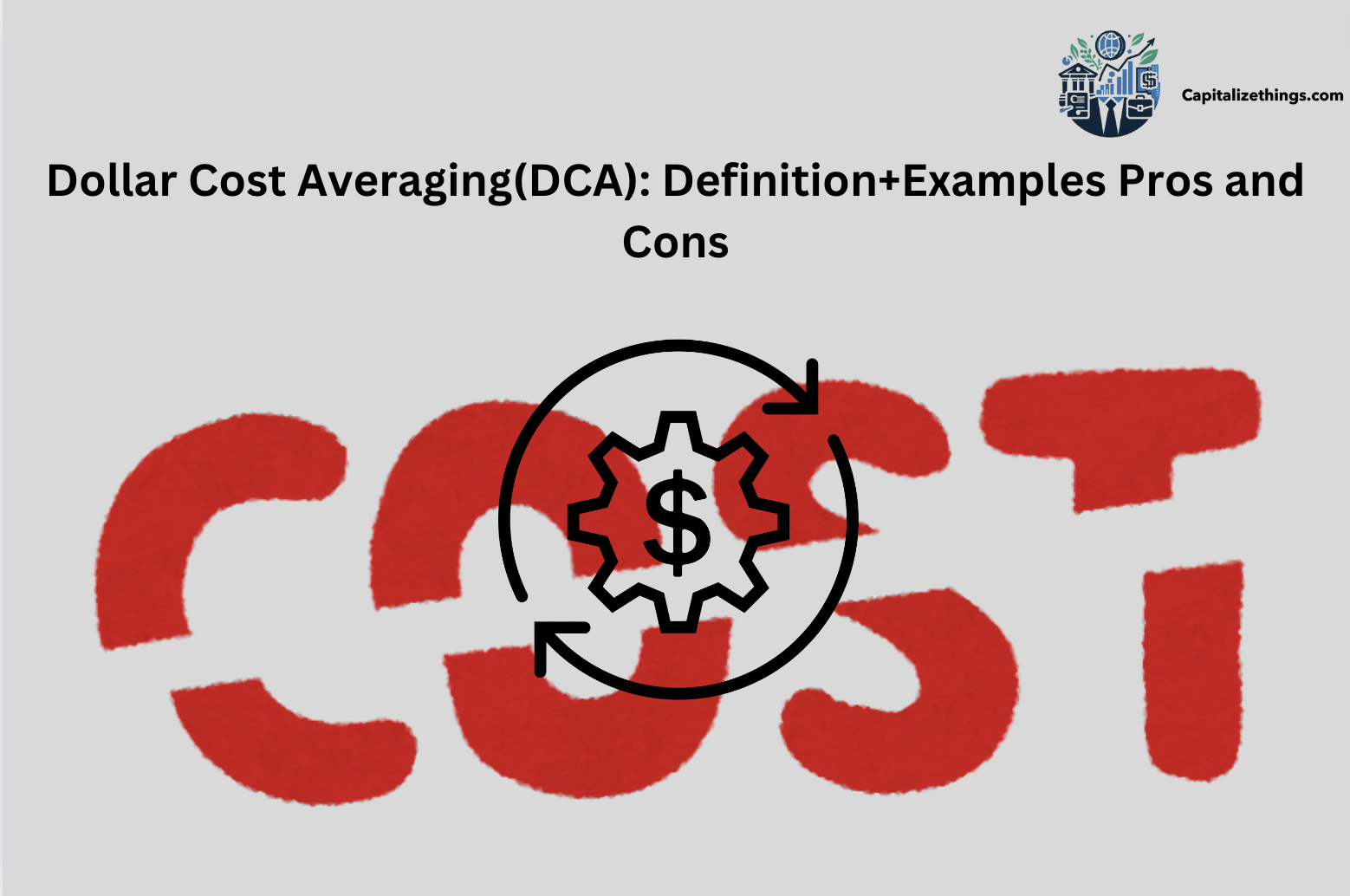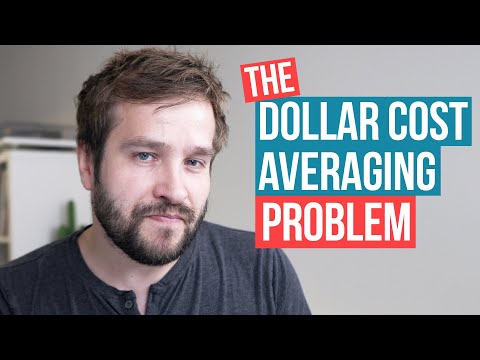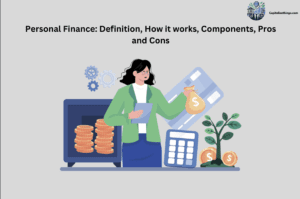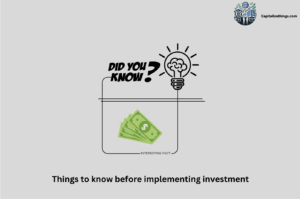Dollar Cost Averaging (DCA) is a way to invest cash. You placed the identical amount of money into an investment at ordinary times, like every month. You do not worry about the price while you purchase. This enables lower the risk of paying an excessive amount at once.
Let’s say you need to buy stocks. You are determined to invest $100 every month. In January, the stock rate is $10, so you buy 10 stocks. In February, the rate goes as much as $20, so that you purchase 5 shares. In March, the fee drops to $5, so that you buy 20 stocks. Over time, you might get greater stocks for less money.
Pros and Cons
- Less stress: You don’t want to fear selecting the first-rate time to buy.
- Simple: It’s clean to install and follow.
- Lowers threat: You avoid buying all your stocks at a high price.
- Misses’ massive profits: If prices move up loads, you won’t get the exceptional deal.
- Costs: Some investments have charges whenever you purchase.
- Not best: It’s now not a guarantee that you may make cash.
What is Dollar Cost Averaging (DCA)?
Dollar cost averaging (DCA) is an investment strategy. You invest the identical amount of cash regularly, irrespective of what the rate is. This follows value investing principles. DCA is also called pound-cost averaging in the UK. It helps lessen the threat of paying too much immediately. You purchase greater stocks while fees are low and fewer stocks when charges are high.
Who Invented the Term Dollar Cost Averaging?
Benjamin Graham invented the term dollar cost averaging.
What is DCA for Dummies?
DCA approaches make investments the equal amount of cash at normal instances. You do not worry about the fee whilst you buy. This way, you get more stocks when charges are low and less while expenses are excessive. It lowers the hazard of buying at a high charge.
What is Dollar-Cost Averaging in Forex Trading?
In forex trading, DCA manners buying a fixed quantity of foreign money at normal times. You buy greater currency while the fee is low and much less when the fee is excessive. This enables control of the threat of fee modifications.
How does Dollar Cost Averaging Work?
Dollar Cost Averaging (DCA) is an investment method wherein you make investments a fixed amount of cash at ordinary durations, no matter the asset’s charge. This method enables minimizing the effect of volatility on the general buy and reduces the risk of making an investment a big quantity in a single funding at the incorrect time.
Example:
Imagine you decide to invest $100 every month in a stock. Here’s how it might appearance over 3 months:
Month 1: Stock price is $10. You buy 10 shares ($100 / $10).
Month 2: Stock price is $20. You buy 5 shares ($100 / $20).
Month 3: Stock price is $5. You buy 20 shares ($100 / $5).
Over those 3 months, you invested $three hundred and acquired 35 shares. The average value in step with share is lower than in case you had invested the complete $300 without delay while the inventory price turned into excessive.
What is the DCA Entry Strategy?
The Dollar Cost Averaging (DCA) entry technique contains making an investment a hard and fast amount of cash in an asset at normal periods, irrespective of the asset’s charge. This technique reduces the impact of marketplace volatility by means of spreading out the funding throughout time, making sure that now not all the coins are invested whilst prices are excessive.
Steps for the DCA Entry Strategy:
- Determine the Total Investment Amount: Decide how much money you want to make investments regular.
- Choose the Investment Frequency: Decide how frequently you may make investments (e.g., weekly, monthly).
- Set the Investment Amount: Divide your universal funding quantity by means of the usage of the variety of intervals to locate the consistent quantity you will invest on every occasion.
- Stick to the Plan: Invest the constant quantity at each selected c programming language, regardless of the marketplace price.
Is Dollar-Cost Averaging a Good Investment Strategy?
Yes, Dollar-Cost Averaging (DCA) is right for lots of investors. It lowers the hazard of buying at a high charge and smooths out the United States of America and downs. It helps construct wealth through the years with much less stress.
Is DCA a Beginner Friendly Strategy for Investors?
Yes, DCA is novice friendly. It is simple and automatic. You make investments a hard and fast amount often, without demanding approximately marketplace timing. This makes it smooth for new traders to start.
How to DCA Effectively?
To DCA effectively, pick a fixed quantity to invest and an everyday agenda, like monthly. Stick to this plan, buy stocks regardless of price, and live regularly. This enables unfolding hazards and decreases the impact of market fluctuations.
Should I DCA Daily or Weekly?
DCA may be each day, weekly, or month-to-month. Daily DCA is probably too common and steeply priced. Weekly or monthly is normally higher for maximum humans. Choose a timetable that fits your finances and desires.
What is Bitcoin Dollar Cost Averaging?
Bitcoin Dollar Cost Averaging (DCA) is a funding method in which you purchase a hard and fast quantity of Bitcoin at regular intervals, no matter the charge. This technique helps reduce the impact of Bitcoin’s charge swings. Bitcoiners use this strategy to “stack sats,” which means gathering small amounts of Bitcoin through the years. By sticking to an ordinary buying agenda, you keep away from seeking to time the marketplace and lower the chance of purchasing Bitcoin at an excessive price. It’s a simple and powerful manner to construct Bitcoin holdings steadily.
Does Dollar-Cost Averaging Work for Crypto?
Yes, Dollar-Cost Averaging (DCA) works for crypto. It allows control of the risk of fee swings with the aid of investing a set amount at normal instances. This method applies to many cryptocurrencies. For example, it could be used for Bitcoin, Ethereum, Binance Coin, Cardano, and Solana. Using DCA, you may build your crypto holdings progressively over time, averting the stress of marketplace timing.
What is the Best Way to DCA Crypto?
The best way to DCA crypto is:
- Choose Your Crypto: Pick which cryptocurrencies to put money into, like Bitcoin or Ethereum.
- Set a Budget: Decide how much money you may make investments regularly.
- Pick a Schedule: Choose how often you’ll invest (e.g., weekly or monthly).
- Automate Investments: Use a platform that lets in automated, recurring purchases.
- Stick to the Plan: Invest continually, regardless of market rate modifications.
This technique facilitates managing threats and building your crypto holdings over time.
Which Crypto Exchange is Best for DCA?
The exceptional crypto exchanges for Dollar-Cost Averaging (DCA) are those that assist computerized, habitual purchases and provide a huge range of property. Coinbase is popular for its person-friendly interface and automatic buy capabilities. Binance supports many assets and gives flexible shopping for options. Kraken offers routine buy functions and several belongings. Gemini is thought for its ease of use and habitual buy options. Crypto.Com also permits computerized investments in numerous assets. These exchanges assist you invest regularly and control your crypto assets efficiently.
Does Warren Buffett use Dollar-Cost Averaging?
Warren Buffett does not use Dollar-Cost Averaging (DCA) normally. He prefers shopping for shares while he believes they’re undervalued. Buffett’s approach involves looking for extremely good organizations to put money into at desirable fees. While DCA is popular for lots, Buffett’s technique focuses extra on the fee of the funding instead of buying regularly through the years.
Why is Dollar-Cost Averaging Good for Retirement?
Dollar-Cost Averaging (DCA) is good for retirement as it facilitates reducing the threat of market timing. By investing a set amount frequently, you buy extra shares while prices are low and less while costs are high. This approach smooths out markets ups and downs, making it less complicated to construct retirement financial savings progressively over the years.
In What Ways do Investors Benefit from Dollar-Cost Averaging?
Investors benefit from Dollar-Cost Averaging (DCA) in numerous approaches. It reduces the danger of making an investment a massive amount at the wrong time. DCA helps easy out the effects of marketplace volatility. It also makes investing less complicated via putting in a regular funding plan. This approach can assist construct wealth step by step and continually.
What Must the Mutual Fund Investor do for the Technique of Dollar-Cost Averaging to Work?
For Dollar-Cost Averaging (DCA) to work, mutual fund buyers must follow an ordinary funding plan. They need to set a set amount to make investments and pick a consistent schedule, like month-to-month. It is essential to stick to this plan and invest regularly, regardless of market conditions, to gain from DCA effectively.
What are the Possible Confusions with Dollar-Cost Averaging Strategy for a Windfall?
Using Dollar-Cost Averaging (DCA) for a windfall gain can cause confusion. DCA is a systematic (delayed) investment strategy where you invest a fixed quantity at normal intervals. However, a few may misinterpret this as a delayed and staged investment strategy method, that is specific. With a windfall, a systematic implementation plan must bear in mind immediate asset allocation to deal with volatility. Unlike DCA, which spreads investments through the years, a providence would possibly require a more instant and strategic technique to control danger and returns.
What is the Difference Between Dollar Cost Averaging and Constant Dollar Plan?
The Difference Between Dollar Cost Averaging and Constant Dollar Plan is that Dollar Cost Averaging (DCA) includes making an investment a set amount of cash at ordinary durations, regardless of the asset’s rate. This facilitates easy out marketplace fluctuations. Whereas the Constant Dollar Plan, however, maintains a hard and fast amount of cash invested in an asset, and any extra price range is invested when the price drops underneath a hard and fast level. DCA specializes in normal investments, while the Constant Dollar Plan adjusts primarily based on market conditions.
What is the Difference Between Dollar Cost Averaging Strategy and Lump sum?
Dollar Cost Averaging (DCA) entails making an investment a hard and fast sum of money at everyday intervals, no matter market rate. This facilitates lessening the chance of making an investment at a high fee. Lump Sum investing means setting all your cash into an asset at one time. DCA spreads out the investment over the years, while Lump Sum invests it abruptly, which can lead to higher danger if the market is at a height.
Should you DCA in a Bull Market?
Yes, Dollar Cost Averaging (DCA) may be used in a bull marketplace. It facilitates you to avoid investing too much whilst charges are excessive and allows you to shop for greater shares whilst fees drop. While a bull market may additionally provide rising prices, DCA gives a scientific way to invest continually and manipulate danger, even during market highs.
Should you DCA in a Bear Market?
Yes, Dollar Cost Averaging (DCA) is useful in an enduring market. It allows you to make investments gradually, buying extra shares while fees are low. This can lower the average price per proportion over time. DCA in a endure marketplace can help you gain from eventual marketplace recoveries and avoid the strain of timing the market.
How do you Calculate Dollar-Cost Averaging Return?
To calculate the go back from Dollar-Cost Averaging (DCA), you operate the harmonic imply of the acquisition charges. This technique averages out the costs over the years. The harmonic mean offers a better estimate than the arithmetic mean as it bills for various amounts of investment. It enables deciding the common fee consistent with proportion. Using the harmonic imply is essential for accurately reflecting the price of shares offered at extraordinary expenses.
What is a DCA in Finance Example?
Dollar-Cost Averaging (DCA) is a financial strategy where you invest a fixed amount of money regularly, regardless of the asset’s price. This helps reduce the impact of market volatility.
| Date | Investment Amount | Share Price | Shares Purchased | Total Shares | Total Investment |
| 01/01/2024 | $100 | $10 | 10 | 10 | $100 |
| 01/02/2024 | $100 | $20 | 5 | 15 | $200 |
| 01/03/2024 | $100 | $25 | 4 | 19 | $300 |
| 01/04/2024 | $100 | $15 | 6.67 | 25.67 | $400 |
In this example, you invest $100 every month regardless of the share price. In January, you buy 10 shares at $10 each. In February, the price rises to $20, so you buy 5 shares. In March, with the price at $25, you purchase 4 shares. In April, the price drops to $15, allowing you to buy 6.67 shares. Over four months, you’ve invested $400 and accumulated 25.67 shares. The average cost per share is calculated using the total investment divided by the total shares purchased. This approach smooths out the effect of price fluctuations over time.
What is an Example of DCA in Crypto?
Dollar-Cost Averaging (DCA) in crypto method looking for a set quantity of cryptocurrency regularly. For example, in case you invest $one hundred in Bitcoin each month, you purchase extra Bitcoin even as expenses are low and lots much less even as expenses are excessive. Over time, this method averages out the purchase rate and decreases the impact of marketplace volatility. If Bitcoin’s fee fluctuates, DCA enables you to keep away from seeking to time the market and may result in a lower common rate in step with Bitcoin over the long time.
How do I Calculate Dollar-Cost Average?
To calculate Dollar-Cost Averaging (DCA), study the ones steps:
- Total Investment: Add up all the cash invested.
- Total Shares: Sum all the shares provided.
- Average Cost: Divide the entire funding using the full shares.
For instance, if you make investments of $300 to buy 15 stocks, the average fee constant with percentage is $300 ÷ 15 = $20 consistent with shares. This technique smooths out the effect of rate fluctuations over time.
How to do Dollar-Cost Averaging in Excel?
To do Dollar-Cost Averaging (DCA) in Excel, comply with the one’s steps:
- Enter Data: List dates, funding quantities, and percent expenses in columns.
- Calculate Shares: Use additives to divide investment amount by percentage rate.
- Sum Shares and Investment: Total the shares offered and the general amount invested.
- Average Cost: Divide the complete funding with the aid of popular stocks.
This approach enables you to tune your investments and calculate the common price in line with percentage effortlessly.
What are the Benefits of Dollar Cost Averaging DCA?
Dollar-Cost Averaging (DCA) offers several advantages. It reduces the effect of marketplace volatility through spreading out investments over the years. This method permits avoiding the hazard of making an investment a massive amount at an excessive rate. It also simplifies making funding thru casting off the need to time the market. Over time, DCA can result in a decreased common fee consistent with share and can help assemble wealth step by step and constantly.
What are the Risks Associated with Dollar Cost Averaging (DCA)?
Dollar-Cost Averaging (DCA) has some risks. It might not completely shield you from market downturns if charges retain to fall. It can also bring about higher commonplace expenses if markets are continuously developing. DCA calls for everyday funding regardless of market situations, which might not constantly be ideal. Additionally, it can lead to neglected possibilities if huge market drops are not absolutely applied.
Is Value Averaging Better than Dollar-Cost Averaging?
Value Averaging (VA) may be higher than Dollar-Cost Averaging (DCA) for some investors. VA adjusts investments based on the price of the portfolio, growing investments while the fee is low and reducing them whilst the value is immoderate. This method pursuits to shop for extra whilst expenses are low and lots less at the same time as expenses are immoderate. While VA can possibly result in better returns, it requires greater monitoring and may be complicated as compared to the simplicity of DCA.
Is DCA a Beginner Friendly Strategy for Investors?
Yes, Dollar-Cost Averaging (DCA) is beginner-friendly investment strategy. It includes investing a set amount of cash at ordinary intervals, which includes month-to-month, no matter marketplace situations. This approach facilitates novices to avoid the strain of marketplace timing and reduces the effect of market volatility. By making an investment regularly, new buyers buy greater shares while fees are low and fewer stocks when fees are high.
This method simplifies making an investment and might help construct wealth over time. It additionally requires much less lively management as compared to other strategies, making it easier for beginners to get started and stay steady with their investments.
What is the common Dollar-Cost Averaging Myth?
One commonplace myth about Dollar-Cost Averaging (DCA) is that it ensures earnings. While DCA reduces the impact of volatility and averages out the purchase price, it does not ensure superb returns. The method can nevertheless result in losses if the marketplace constantly declines. Another fable is that DCA is only beneficial in volatile markets. In fact, DCA can be effective in both rising and falling markets. It’s additionally believed that DCA gets rid of the want for studies or marketplace timing, however know-how marketplace traits and funding selections remain critical for successful investing.
How do you Calculate Average Cost Per Unit in Unit Trust?
To calculate the common cost consistent with unit in a unit accept as true with, comply with these steps:
- Total Investment: Add up all the quantities invested within the unit.
- Total Units: Sum all the gadgets purchased through the years.
- Average Cost: Divide the whole funding via the whole devices purchased.
For example, in case you make an investment of $1,000 and buy 100 devices, then invest another $500 to buy 50 more units, the whole funding is $1,500 and the whole gadgets are 150. The average fee in line with the unit is $1,500 ÷ 150 = $10 in line with the unit.
Does Dollar-Cost Averaging Work with Mutual Funds?
Yes, Dollar-Cost Averaging (DCA) works nicely with a mutual price range. With DCA, you make investments in a fixed quantity regularly, including month-to-month, into a mutual fund. This method allows spread out the funding and decreases the hazard of making an investment in a large quantity at a high fee. It also can assist easy out the outcomes of marketplace fluctuations. Mutual funds are an amazing suit for DCA due to the fact they offer diversification and are typically installation for ordinary investments. By using DCA, investors can avoid seeking to time the marketplace and gain from a lengthy-time period boom.
Where is DCA in Binance?
On Binance, you can use Dollar-Cost Averaging (DCA) via putting in place routine purchase orders for cryptocurrencies. To try this, go to the “Buy Crypto” phase and pick out “Recurring Buy.” Here, you could pick the cryptocurrency you want to invest in and set up a hard and fast quantity to be offered at normal periods, which include daily, weekly, or monthly. Binance will routinely execute these buy orders according to your agenda. This feature allows you implement a DCA approach by allowing you to invest progressively over time, reducing the impact of marketplace volatility.
Conclude
Dollar-Cost Averaging (DCA) is a strategy where practitioners regularly invest a fixed amount in common stocks or other assets like cryptocurrencies. It helps reduce price risk through incremental trading, avoiding market timing and smoothing out the cost per share. DCA is all about hedging your bets and balancing investments to manage volatility and the cost average effect.
For investors, DCA offers a behavioral economics advantage by mitigating the impact of market fluctuations and rebalancing investments over time. It minimizes the asymmetry of price risks, allowing for more consistent buying of shares or currencies, while also facilitating unit cost averaging. This approach can make long-term investing simpler and more effective.

Larry Frank is an accomplished financial analyst with over a decade of expertise in the finance sector. He holds a Master’s degree in Financial Economics from Johns Hopkins University and specializes in investment strategies, portfolio optimization, and market analytics. Renowned for his adept financial modeling and acute understanding of economic patterns, John provides invaluable insights to individual investors and corporations alike. His authoritative voice in financial publications underscores his status as a distinguished thought leader in the industry.








